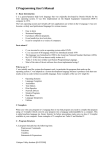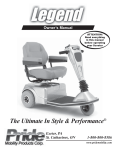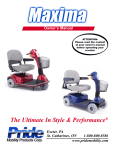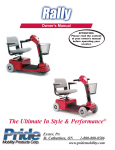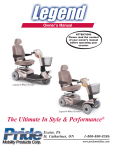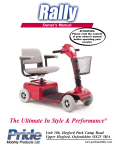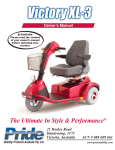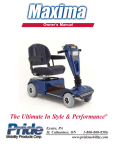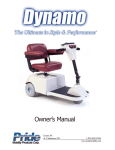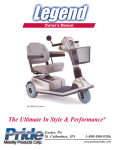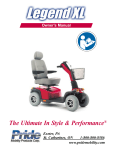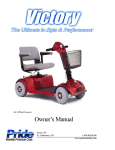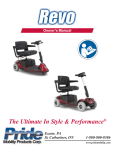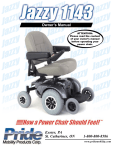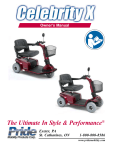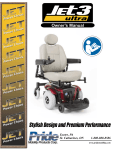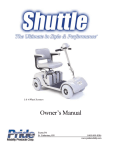Download The Ultimate In Style & Performance®
Transcript
Owner’s Manual The Ultimate In Style & Performance® Exeter, PA St. Catharines, ON 1-800-800-8586 www.pridemobility.com S A F E T Y G U I D E L I N E S Please read and follow all instructions in this owners manual before attempting to operate your scooter for the first time. If there is anything in this manual you do not understand, or if you require additional assistance for setup, contact your authorized Pride provider. Using your Pride product safely depends upon your diligence in following the warnings, cautions, and instructions in this owners manual. Using your Pride product safely also depends upon your own good judgement and/or common sense, as well as that of your provider, caregiver, and/or healthcare professional. Pride is not responsible for injuries and/or damage resulting from any persons failure to follow the warnings, cautions, and instructions in this owners manual. Pride is not responsible for injuries and/or damage resulting from any persons failure to exercise good judgement and/or common sense. The symbols below are used throughout this owners manual to identify warnings and cautions. It is very important for you to read and understand them completely. WARNING! Failure to heed the warnings in this owners manual may result in personal injury. CAUTION! Failure to heed the cautions in this owners manual may result in damage to your scooter. Copyright ©2002 Pride Mobility Products Corp. INFMANU1752/REV C/OCTOBER 2002 2 Vista C O Ncontents T E N T S I. INTRODUCTION......................................................................................................................... 4 II. SAFETY ......................................................................................................................................... 6 III. EMI/RFI ........................................................................................................................................ 15 IV. SPECIFICATIONS ................................................................................................................... 17 V. YOUR VISTA .............................................................................................................................. 19 VI. BATTERIES AND CHARGING ............................................................................................ 24 VII. OPERATION ............................................................................................................................... 28 VIII. COMFORT ADJUSTMENTS................................................................................................ 30 IX. DISASSEMBLY AND ASSEMBLY ..................................................................................... 32 X. OPTIONAL ACCESSORIES ................................................................................................. 34 XI. BASIC TROUBLESHOOTING ............................................................................................. 35 XII. CARE AND MAINTENANCE ................................................................................................ 36 XIII. WARRANTY ............................................................................................................................... 38 VISTA Vista 3 I N T R O D U C T I O N Welcome to Pride Mobility Products Corporation (Pride). Congratulations on the purchase of your new Pride Scooter. Your scooter design combines the most advanced state-of-the-art components with modern, attractive styling. We are certain that the design features and trouble-free operation will add convenience to your daily living and ensure complete satisfaction. At Pride, your safety is important to us. Please read and follow all of the instructions in this manual before you attempt to operate your scooter for the first time. These instructions were produced for your benefit. Your understanding of these instructions is essential for the safe operation of your new Pride Scooter. Pride is not liable for damage to property or personal injury arising out of the unsafe use of a Pride Scooter. Pride is also not liable for any property damage or personal injury arising out of the failure of any person and/or user to follow the instructions and recommendations set forth in this manual or any other instructions or recommendations contained in other scooter related literature issued by Pride or contained on the Pride Scooter itself. This owners manual is compiled from the latest specifications and product information available at the time of publication. We reserve the right to make changes as they become necessary. Any changes to our products may cause slight variations between the illustrations and explanations in this manual and the product you have purchased. If you experience any problems with your scooter that your are not able to solve, or if you do not feel capable of safely following any of the instructions and/or recommendations contained in this manual, please contact your authorized Pride provider for assistance. Once you understand how to operate and take care of your scooter, we are certain that it will give you years of troublefree service and enjoyment. Information Exchange We want to hear your questions, comments, and suggestions regarding this manual. We would also like to hear about the safety and reliability of your new Pride Scooter, and the service you received from your authorized Pride provider. Please notify us of any change of address so we can keep you apprised of important information regarding safety, new products, and new options that can increase your ability to use and enjoy your Pride Scooter. Please feel free to write us at the address below: Pride Mobility Products Corporation Attn: Technical Service Department 182 Susquehanna Avenue Exeter, PA 18643-2694 4 Vista I N T R O D U C T I O N Pride Owners Club As a Pride product owner, you are invited to register your products warranty and enroll in the Pride Owners Club. You may do so by filling out and returning your enclosed registration card or by visiting Prides web site at www.pridemobility.com. As a registered member, each time you visit our site, you will have access to the most interactive and honest educational venue available today for people with mobility needs, their families, and friends. From our home page, click on the button that reads Owners Club to enter a page dedicated to current and potential Pride product owners. You will gain access to interviews, stories, recreation ideas, daily living tips, product and funding information, and interactive message boards. These message boards invite you to speak with other Pride customers as well as Pride representatives who are available to assist you with any questions or concerns you may have. My Authorized Pride Provider Is: Name:_______________________________________________________________________________ Address:_____________________________________________________________________________ Phone Number:________________________________________________________________________ Quick Reference Information: Scooter Model:________________________________________________________________________ Serial Number:__________________________________________________________________________ Purchase Date:________________________________________________________________________ NOTE: If you ever lose or misplace your warranty card or this owners manual, call or write to us and we will be glad to send you a new one immediately. Vista 5 I I . S A F E T Y GENERAL WARNING! Do not operate your new scooter for the first time without completely reading and understanding this owners manual. Your scooter is a state-of-the-art life-enhancement device designed to increase mobility. Pride provides an extensive variety of products to best fit the individual needs of the scooter user. Please be aware that the final selection and purchasing decision regarding the type of scooter to be used is the responsibility of the scooter user who is capable of making such a decision and his/her healthcare professional (i.e., medical doctor, physical therapist, etc.). The contents of this manual are based on the expectation that a mobility device expert has properly fitted the scooter to the user and has assisted the prescribing healthcare professional and/or the authorized Pride provider in the instruction process for the use of the product. There are certain situations, including some medical conditions, where the scooter user will need to practice operating the scooter in the presence of a trained attendant. A trained attendant can be defined as a family member or care professional specially trained in assisting a scooter user in various daily living activities. As you begin using your scooter during daily activities, you will probably encounter situations in which you will need some practice. Simply take your time and you will soon be in full and confident control as you maneuver through doorways, on and off elevators, up and down ramps, and over moderate terrain. Below are some precautions, tips, and other safety considerations that will help the user become accustomed to operating the scooter safely. MODIFICATIONS Pride has designed and engineered your scooter to provide maximum mobility and utility. A wide range of accessories is available from your authorized Pride provider to further customize your scooter to better suit your needs and/or preferences. However, under no circumstances should you modify, add, remove, or disable any feature, part, or function of your scooter. WARNING! Do not modify your scooter in any way not authorized by Pride. Unauthorized modifications may result in personal injury and/or damage to your scooter. 6 Vista I I . S A F E T Y PRE-RIDE SAFETY CHECK Get to know the feel of your scooter and its capabilities. Pride recommends that you perform a safety check before each use to make sure your scooter operates smoothly and safely. For details on how to perform these necessary inspections, see XII. Care and Maintenance. Perform the following inspections prior to using your scooter: n Check for proper tire inflation. Maintain 30-35 psi in each tire (if equipped with pneumatic tires). n Check all electrical connections. Make sure they are tight and not corroded. n Check all controller connections to the utility tray. Make sure they are secured properly. n Check the brakes. n Check battery charge. WARNING! It is critically important that 30-35 psi tire pressure be maintained in pneumatic tires at all times. Failure to maintain 30-35 psi tire pressure in pneumatic tires at all times may result in catastrophic tire and/or wheel failure, causing serious personal injury and/or damage to your scooter. WARNING! Do not carry passengers on your scooter. Carrying passengers on your scooter may result in personal injury and/or property damage. If you discover a problem, contact your authorized Pride provider for assistance. WEIGHT LIMITATIONS Your scooter is rated for a 300-lb. maximum weight limit. WARNING! Exceeding the weight limit voids your warranty and may result in personal injury and damage to your scooter. Pride will not be held responsible for injuries and/or property damage resulting from failure to observe weight limitations. INCLINE INFORMATION More and more buildings have ramps with specified degrees of inclination, designed for easy and safe access. Some ramps may have turning switchbacks (180-degree turns) that require you to have good cornering skills on your scooter. n Proceed with extreme caution as you approach the downgrade of a ramp or other incline. n Take wide swings with your scooters front wheel around any tight corners. If you do that, the scooters rear wheels will follow a wide arc, not cut the corner short, and not bump into or get hung up on any railing corners. n When driving down a ramp, keep the scooters speed adjustment set to the slowest speed setting to ensure a safely controlled descent. See V. Your Vista. n Avoid sudden stops and starts. Vista 7 I I . S A F E T Y When climbing an incline, try to keep your scooter moving. If you must stop, start up again slowly, and then accelerate cautiously. When driving down an incline, do so by setting the speed adjustment dial to the slowest setting and driving in the forward direction only. If your scooter starts to move down the incline faster than you anticipated or desired, allow it to come to a complete stop by releasing the throttle control lever. Then push the throttle control lever forward slightly to ensure a safely controlled descent. WARNING! When climbing an incline, do not zigzag or drive at an angle up the face of the incline. Drive your scooter straight up the incline. This greatly reduces the possibility of a tip or a fall. Always exercise extreme caution when negotiating an incline. WARNING! You should not travel up or down a potentially hazardous incline (i.e., areas covered with snow, ice, cut grass, or wet leaves). WARNING! When on any sort of an incline or decline, never place the scooter in freewheel mode while seated on it or standing next to it. Other inclines may be natural or, if man-made, not designed specifically for scooters. Figure 1 illustrates your scooters stability and its ability to climb grades under various weight loads and under controlled testing conditions. These tests were conducted with the Vistas seat in the highest position and adjusted backward on the seat base to its farthest rearward position. Use this information as a guideline. Your Vistas ability to travel up inclines is affected by your weight, your scooters speed, your angle of approach to the incline, and your scooter setup. 150 lbs. 200-250 lbs. 300 lbs. 7º 6º 5º FIGURE 1. MAXIMUM RECOMMENDED INCLINE ANGLES WARNING! Any attempt to climb or descend a slope steeper than shown in figure 1 may put your scooter in an unstable position and cause it to tip, resulting in personal injury. 8 Vista I I . S A F E T Y When you approach an incline, it is best to lean forward. See figures 2 and 3. This shifts the center of gravity of you and your scooter toward the front of the scooter for improved stability. WARNING! Do not exceed the incline guidelines or any other specifications presented in this manual. FIGURE 2. NORMAL DRIVING POSITION FIGURE 3. INCREASED STABILITY DRIVING POSITION CORNERING INFORMATION Excessively high cornering speeds can create the possibility of tipping. Factors which affect the possibility of tipping include, but are not limited to, cornering speed, steering angle (how sharply you are turning), uneven road surfaces, inclined road surfaces, riding from an area of low traction to an area of high traction (such as passing from a grassy area to a paved area especially at high speed while turning), and abrupt directional changes. High cornering speeds are not recommended. If you feel that you may tip over in a corner, reduce your speed and steering angle (i.e., lessen the sharpness of the turn) to prevent your scooter from tipping. WARNING! When cornering sharply, reduce your speed. When using your scooter at higher speeds, do not corner sharply. This greatly reduces the possibility of a tip or fall. To avoid personal injury or property damage, always exercise common sense when cornering. Vista 9 I I . S A F E T Y BRAKING INFORMATION Your scooter is equipped with two powerful brake systems: 1. Regenerative: Uses electricity to rapidly slow the vehicle when the throttle control lever returns to the center/ stop position; and 2. Disc Park Brake: Activates mechanically after regenerative braking slows the vehicle to near stop, or when power is removed from the system for any reason. Brake engagement is far more abrupt at higher speeds. It is important that you know when the brakes will engage, and that you are braced for the resulting deceleration. WARNING! Your scooter can decelerate very quickly. Do not decelerate or turn abruptly when traveling at high speed unless absolutely necessary. If it is absolutely necessary to decelerate or turn abruptly when traveling at high speed, brace yourself by gripping the tiller tightly and planting your feet firmly against the floorboard. Users who cannot grip the tiller tightly and/or plant their feet firmly against the floorboard should avoid decelerating from or turning abruptly at high speed, and therefore should avoid traveling at high speed. Serious personal injury and property damage can result from falling forward as your scooter decelerates quickly unless you brace yourself firmly. OUTDOOR DRIVING SURFACES Your scooter is designed to provide optimum stability under normal driving conditionsdry, level surfaces composed of concrete, blacktop, or asphalt. However, Pride recognizes that there will be times when you will encounter other surface types. For this reason, your scooter is designed to perform admirably on packed soil, grass, and gravel. Feel free to use your scooter safely on lawns and in park areas. n n n n Reduce your scooters speed when driving on uneven terrain and/or soft surfaces. Avoid tall grass that can become tangled in the running gear. Avoid loosely packed gravel and sand. If you feel unsure about a driving surface, avoid that surface. STATIONARY OBSTACLES (STEPS, CURBS, ETC.) Proceed with extreme caution when driving near raised surfaces, unprotected ledges and/or drop-offs (curbs, porches, stairs, etc.). WARNING! Do not attempt to have your scooter climb or descend an obstacle that is inordinately high. Serious personal injury and/or damage may result. WARNING! Do not attempt to have your scooter proceed backwards down any step, curb, or other obstacle. This may cause the scooter to tip and cause personal injury. 10 Vista I I . S A F E T Y PUBLIC ROADS AND PARKING LOTS WARNING! You should not operate your scooter on public streets and roadways. Be aware that it may be difficult for traffic to see you when you are seated on your scooter. Obey all local pedestrian traffic rules. Wait until your path is clear of traffic, and then proceed with extreme caution. NOTE: Safety accessories like reflectors, fluorescent flags, and various lighting packages are available to order from your authorized Pride provider. INCLEMENT WEATHER PRECAUTIONS WARNING! Pride recommends that you do not operate your scooter in icy or slippery conditions or on salted surfaces (i.e., walks or roads). Such use may result in an accident, personal injury, or adversely affect the performance and safety of your scooter. WARNING! Pride recommends that you do not expose your scooter to any type of moisture at any time (rain, snow, mist, or wash). Such exposure can damage your scooter. Never operate your scooter if it has been exposed to moisture until it has dried thoroughly. FREEWHEEL MODE Your scooter is equipped with a manual freewheel lever that when pulled up allows the scooter to be pushed. For more information about how to place your scooter into and out of freewheel mode, see V. Your Vista. WARNING! Do not use your scooter in freewheel mode without an attendant present. Personal injury may result. WARNING! Do not attempt to personally place your scooter in freewheel mode while seated on it. Personal injury may result. Ask an attendant for assistance if necessary. WARNING! Do not place your scooter in freewheel mode while on an incline. The scooter could roll uncontrollably on its own, causing personal injury. TIRE INFLATION If your scooter is equipped with pneumatic tires, you should check or have the air pressure checked at least once a week. Proper inflation pressures will prolong the life of your tires and help ensure the smooth operation of your scooter. WARNING! It is critically important that pneumatic tires be inflated to 30-35 psi. Do not underinflate or overinflate your tires. Improper tire pressure may result in catastrophic tire and/or wheel failure. Serious personal injury and/or property damage may result. WARNING! Inflate your scooter drive tires from a regulated air source with an available pressure gauge. Minimum air pressure for scooter drive tires is 30-35 psi. Inflating your tires from an unregulated air source could overinflate them, resulting in a burst tire and/or personal injury. Vista 11 I I . S A F E T Y STAIRS AND ESCALATORS Scooters are not designed to travel up or down stairs or escalators. Always use an elevator. WARNING! Do not use your scooter to negotiate steps or escalators. You may cause injury to yourself and to others and damage your scooter. DOORS n Determine if the door opens toward or away from you. n Use your hand to turn the knob or push the handle or push-bar. n Drive your scooter gently and slowly forward to push the door open. Or drive your scooter gently and slowly backwards to pull the door open. ELEVATORS Modern elevators have a door edge safety mechanism that, when pushed, reopens the elevator door(s). n If you are in the doorway of an elevator when the door(s) begin to close, push on the rubber door edge or allow the rubber door edge to contact the scooter and the door will reopen. n Use care that pocketbooks, packages, or scooter accessories do not become caught in elevator doors. LIFT/ELEVATION PRODUCTS If you will be traveling with your scooter, you may find it necessary to use a lift/elevation product to aid in transportation. Pride recommends that you closely review the instructions, specifications, and safety information set forth by the manufacturer of the lift/elevation product before using that product. BATTERIES In addition to following the warnings below, be sure to comply with all other battery handling information. For more information about your scooters batteries, see VI. Batteries and Charging. WARNING! 32 AH scooter batteries weigh 25 lbs. each. If you are unable to lift that much weight, be sure to get help. Lifting beyond your capacity can result in personal injury. WARNING! Battery posts, terminals, and related accessories contain lead and lead compounds. Wash hands after handling. WARNING! Always protect the batteries from freezing and never charge a frozen battery. Charging a frozen battery may result in personal injury and/or damage to the battery. PREVENTING UNINTENDED MOVEMENT WARNING! If you anticipate being seated in a stationary position for an extended period of time, turn off the power. This will prevent unexpected motion from inadvertent throttle control lever contact. Failure to do so may result in personal injury. 12 Vista I I . S A F E T Y MOTOR VEHICLE TRANSPORT Currently, there are no standards approved for tie-down systems in a moving vehicle of any type to transport a person while seated in a scooter. Although your scooter may be equipped with a positioning belt, this belt is not designed to provide proper restraint during motor vehicle transport. Anyone traveling in a motor vehicle should be properly secured in the motor vehicle seat with safety belts fastened securely. WARNING! Do not sit on your scooter while it is in a moving vehicle. Personal injury and/or property damage may result. WARNING! Always be sure your scooter and its batteries are properly secured when it is being transported. Failure to do so may result in personal injury and/or damage to your scooter. GETTING ONTO AND OFF OF YOUR SCOOTER Getting onto and off of your scooter requires a good sense of balance. Please observe the following safety tips when getting onto and off of your scooter: n n n n Power down your scooter. See VII. Operation. Ensure that your scooter is not in freewheel mode. See V. Your Vista. Make certain that the seat is locked into place and the key is removed from the key switch. The seat armrests can be flipped up to make getting on and off the scooter easier. WARNING! Position yourself as far back as possible in the scooter seat to prevent the scooter from tipping and causing injury. WARNING! Avoid using your armrests for weight bearing purposes. Such use may cause the scooter to tip and cause personal injury. WARNING! Avoid putting all of your weight on the floorboard. Such use may cause the scooter to tip and cause personal injury. POSITIONING BELTS Your authorized Pride provider, therapist(s), and other healthcare professionals are responsible for determining your requirement for a positioning belt in order to operate your scooter safely. WARNING! If you require a positioning belt to safely operate your scooter, make sure it is fastened securely. Serious personal injury may result if you fall from the scooter. Vista 13 I I . S A F E T Y REACHING AND BENDING Avoid reaching or bending while driving your scooter. When reaching, bending, or leaning while seated on your scooter, it is important to maintain a stable center of gravity and keep the scooter from tipping. Pride recommends that the scooter user determine his/her personal limitations and practice bending and reaching in the presence of a qualified healthcare professional. WARNING! Do not bend, lean, or reach for objects if you have to pick them up from the floor by reaching down between your knees. Movements such as these may change your center of gravity and the weight distribution of the scooter and cause your scooter to tip, possibly resulting in personal injury. Keep your hands away from the tires when driving. PRESCRIPTION DRUGS/PHYSICAL LIMITATIONS The scooter user must exercise care and common sense when operating his/her scooter. This includes awareness of safety issues when taking prescribed or over-the-counter drugs or when the user has specific physical limitations. WARNING! Consult your physician if you are taking prescribed or over-the-counter medication or if you have certain physical limitations. Some medications and limitations may impair your ability to operate your scooter in a safe manner. ALCOHOL The scooter user must exercise care and common sense when operating his/her scooter. This includes awareness of safety issues while under the influence of alcohol. WARNING! Do not operate your scooter while you are under the influence of alcohol, as this may impair your ability to drive safely. REMOVABLE PARTS WARNING! Do not attempt to lift or move a scooter by any of its removable parts. Personal injury and damage to the scooter may result. 14 Vista I I I . E M I / R F I EMI/RFI WARNINGS Laboratory tests performed by the Food and Drug Administration (FDA) have shown that radio waves can cause unintended motion of electric scooters. Radio waves are a form of electromagnetic energy (EM). When electromagnetic energy adversely affects the operation of an electrical device, that adverse effect is called Electromagnetic Interference (EMI) or Radio Frequency Interference (RFI). EMI/RFI FREQUENTLY ASKED QUESTIONS (FAQS) The following FAQs summarize what you should know about EMI/RFI. Use this information to minimize the risk that EMI/RFI will adversely affect your scooter. Where do radio waves come from? Radio waves are emitted from the antennas of cellular phones, mobile two-way radios (such as walkie-talkies and CBs), radio stations, TV stations, amateur radio (HAM) transmitters, wireless computer links, microwave sources, and paging transmitters. Radio waves are a form of EM. Because EM is more intense closer to transmitting antennas (sources of emission), the EM fields from two-way radios are of special concern to electric scooter users. If EMI/RFI affects my scooter, what kind of motion should I expect? This is difficult to predict. The answer would depend on a number of factors: n The strength of the radio waves. n The construction of your particular scooter. n The location of your scooter (whether it is on level ground or on an incline). n Whether or not your scooter is in motion. The motion of any electric scooter affected by EMI/RFI can be erratic. The scooter may come to a sudden stop or move in an uncontrolled manner. Also, it is possible for EMI/RFI to release the brakes of an electric scooter. Some intense EMI/RFI can even damage the control system components of an electric scooter. Is there any way to know for certain whether or not radio waves are the cause of any unintended motion of my scooter? Unfortunately, EMI/RFI may be difficult to recognize, since the signals from radio sources are invisible and may be intermittent. However, the FDA recommends that you report all incidents of unintended motion or unintended brake release of your electric scooter to the scooters manufacturer and, if possible, determine whether or not there was a radio wave source nearby at the time of the incident. One precaution you can take against inadvertent motion of your scooter is to make certain that you or someone else is not the cause of the unintended motion. n Turn off your scooter by removing the key from the key switch when you are getting on or off of your scooter. n Never leave the key in the key switch of an unattended scooter. By following these steps, you greatly reduce the risk of you or anyone else inadvertently bumping the throttle control levers and causing the scooter to move unintentionally. Are all scooters susceptible to EMI/RFI? Each make and model of electric scooter differs in its ability to resist EMI/RFI. That is, each scooter has a particular level of resistance to EMI/RFI. This resistance is measured in volts per meter (V/m). A higher resistance level offers greater protection against EMI/RFI. In other words, an electric scooter with a high resistance level is less likely to be affected by a strong radio source than is an electric scooter with a low resistance level. Vista 15 I I I . E M I / R F I What is the FDA doing about the problem? The FDA has written to electric scooter manufacturers and requested that those manufacturers test their new scooter models to be certain that they provide a reasonable degree of resistance against EMI/RFI. The FDA has stated that all newly-manufactured models of electric scooters should have a resistance level of at least 20 V/m. This resistance level provides a reasonable degree of protection against the common sources of EMI/RFI. The FDA has also requested or recommended that: n Electric scooter manufacturers clearly label new products with that products resistance level or state that the resistance level is not known. n The labeling or informational material supplied with new electric scooters must explain what the resistance level means and warn users about the possibility of EMI/RFI and how to avoid it. n Electric scooter manufacturers undertake an educational program to inform electric scooter users and their caregivers about the problems associated with EMI/RFI and about the actions they can take to minimize the risk of EMI/RFI. n While there is no exact way to tell if your scooter is totally safe, an immunity level of 20 V/m is generally achievable. This product has been tested and passed at an immunity level of 20 V/m. Adding accessories and components or modifying the unit may change the susceptibility to EMI/RFI. What can I do to find out if my scooter is likely to be affected by EMI/RFI? If you have had your scooter for some time and have not experienced any unintended motion, it is not likely that you will have a problem in the future. However, it is always possible that EMI problems could arise if you are close to a source of radio waves. Therefore, it is very important for you to be alert to this possibility. The scooter meets or exceeds a resistance level of at least 20 V/m. What can I do to reduce the risk of my scooter being affected by EMI/RFI? Here are some precautions you can take: n Do not turn on or use hand-held personal communications devices, such as citizens band (CB) radios and cellular phones, while your scooter is turned on. n Be aware of nearby radio wave transmitters, such as radio or TV stations and hand-held or mobile two-way radios. Try not to operate your scooter too close to those transmitters. For example, if you are on an electric scooter with a resistance level of at least 20 V/m, you should remain at least three feet from a hand-held twoway radio and at least ten feet from a mobile two-way radio. n Be aware that adding accessories and/or components, or modifying your scooter in any way, may change its EMI/RFI resistance level and may make it more susceptible to interference from radio wave sources. What should I do if my scooter moves unexpectedly? If unintended motion or unintended brake release occurs, turn off your scooter (by removing the key) as soon as it is safe to do so. If my scooter moves unintentionally, where should I report the incident? Call our headquarters at 1-800-800-8586 to report the incident. 16 Vista I V. S P E C I F I C AT I O N S 12 " 7 1 2" 80˚ 33 1 2" - 35 1 2 " 17 " - 19" 4 1 2" FIGURE 4. VISTA DIMENSIONS 46" Length 18" 16" 32" 21"- 29" Turning Radius 24 " Vista 17 I V. Model Numbers Length Width Tires Weight Capacity Battery Type (Batteries not included) Horsepower Charger Speed Maximum Grade Range Turning Radius Body Colors Seating S P E C I F I C AT I O N S SC166CRED 46 in. 24 in. Type: Pneumatic Front: 3.5 in. x 10 in. Rear: 3.5 in. x 10 in. 300 lbs. maximum Two 12V, 32 AH, U-1 type, SLA (sealed lead-acid) 1.1 hp (peak) Onboard 3-amp charger Variable up to 5 mph See figure 1 Up to 20-25 miles 32 in. Painted: Candy Apple Red Style: Foldable molded plastic; removable seat covers with foam inserts are attached to seat. Dimensions: 18 in. width (usable) x 12 in. height (usable) x 16 in. depth Seat cover material: Gray or Black vinyl or fabric Armrests: Gray molded rubber User adjustable seat height from ground: 21.5 in., 22.5 in., or 23.5 in. User adjustable seat height from scooter deck: 17 in., 18 in., or 19 in. Included Features Brakes Rear Wheel Drive Wheels Tiller Type Freewheel Mechanism Weight of Scooter Front-to-Rear Lockup Ground Clearance Optional Accessories 18 Adjustable seat height and positioning, external freewheel release lever, front basket, external circuit breaker, easily accessible charger power cord receptacle, recessed headlight, onboard accessory bracket Electronic regenerative braking and electromechanical disc brake Transaxle, 24V Aluminum alloy wheels in Black Adjustable Freewheel release lever located upon upper-right rear portion of rear shroud Total weight of the Vista with two 12V, 32 AH batteries = 152 lbs. Component breakdown: Front section: 32.5 lbs. Rear section (without batteries or rear shroud): 45.0 lbs. Rear plastic shroud: 3.5 lbs. Seat: 21.0 lbs. Batteries 12V, 32AH: 25.0 lbs.(each) (Note: two batteries are required per scooter) Lock pin and dual camlock lever system 4.5 in. Taillight, safety flag, cane/crutch holder, walker holder, rearview mirror, oxygen holder, single and double crutch holder, cane/crutch holder (bracket mount), cane/crutch holder (armrest mount), rear basket, Slime tire sealant Vista V. YO U R V I S TA Your Vista is a motorized electric scooter designed to enhance your personal mobility. Your Vista is an indoor/ outdoor scooter designed to travel primarily on smooth surfaces such as sidewalks, roads, parking lots, floors, and driveways. For easy transportation or storage, you can disassemble your Vista into seven components. See figure 5. SEAT REAR SECTION FRONT SECTION REAR SHROUD BATTERIES BASKET FIGURE 5. SEVEN VISTA COMPONENTS CONTROL CONSOLE ASSEMBLY The control console assembly houses all the controls you need to drive your Vista, including the key switch, the speed adjustment dial, the throttle control lever, the battery condition meter, the horn button, and the light switch. See figure 6. WARNING! Do not expose the control console assembly to moisture. In the event that the console does become exposed to moisture, do not attempt to operate your Vista until the console has dried thoroughly. BATTERY CONDITION METER KEY SWITCH KEY SPEED ADJUSTMENT DIAL LIGHT SWITCH HORN BUTTON THROTTLE CONTROL LEVER THROTTLE CONTROL LEVER FIGURE 6. CONTROL CONSOLE ASSEMBLY Key Switch n Fully insert the key into the key switch to power up (turn on) your Vista. n Pull the key out to power down (turn off) your Vista. WARNING! If the key is removed from the key switch while your Vista is in motion, the electronic brakes will engage and your Vista will come to an abrupt stop! Vista 19 V. YO U R V I S TA Speed Adjustment Dial This adjustment dial allows you to preselect and limit your Vista’s top speed. n The image of the tortoise represents the slowest speed setting. n The image of the hare represents the fastest speed setting. Throttle Control Lever This lever allows you to control the forward speed and the reverse speed of your Vista up to the maximum speed preset at the speed adjustment dial. n Place your right hand on the right handgrip and your left hand on the left handgrip. n Use your right thumb to push the right side of the lever to disengage your Vistas brake and move forward. n Release the lever and allow your Vista to come to a complete stop before pushing the left side of the lever to move in reverse. n When the throttle control lever is completely released, it automatically returns to the center stop position and engages your Vistas brake. Battery Condition Meter Whenever you have the key fully inserted, this meter gives an approximate reading of your Vistas battery voltage. Horn Button n The key must be fully inserted into the key switch for the horn to be operational. n This button activates a warning horn. n Do not hesitate to use the warning horn when you feel its use will prevent accident or injury. Light Switch This switch controls your Vistas headlight system. n Toggle the switch up to turn the light on. n Toggle the switch down to turn the light off. 20 Vista V. YO U R V I S TA REAR SECTION The onboard battery charger, the charger power cord receptacle, the battery charger fuse, the batteries, the electronic controller module, the main circuit breaker (reset button), the manual freewheel lever, and the motor/ transaxle assembly are located on the rear section of your Vista. See figure 7. Refer to IX. Disassembly and Assembly for instructions on removing the rear shroud. BATTERIES ONBOARD BATTERY CHARGER BATTERY CHARGER FUSE ELECTRONIC CONTROLLER MODULE MAIN CIRCUIT BREAKER(RESET BUTTON) MANUAL FREEWHEEL LEVER MOTOR/TRANSAXLE ASSEMBLY CHARGER POWER CORD RECEPTACLE ANTI-TIP WHEELS FIGURE 7. REAR SECTION Onboard Battery Charger The onboard battery charger converts household current (AC) to direct current (DC) and charges the batteries of your Vista. See VI. Batteries and Charging. n The charger is located behind the batteries and at the forward right corner of the rear section. n The charger power cord plugs into your Vistas battery charger by means of a receptacle located on the rear section of your Vista, near the manual freewheel lever and the main circuit breaker reset button. See figure 7. Batteries The batteries store the electrical energy that powers your Vista. See VI. Batteries and Charging. Electronic Controller Module The electronic controller module is located behind the batteries and at the forward left corner of the Vistas rear section. This assembly receives electrical signals from the console controls and sends power to the motor, the brakes, and the headlight. Vista 21 V. YO U R V I S TA Main Circuit Breaker When the voltage in your Vistas batteries becomes low or your Vista is heavily strained because of excessive loads or steep inclines, the main circuit breaker may trip to protect your Vistas motor and electronics from damage. n The main circuit breaker is mounted on the rear section of the Vista. See figure 7. n The main circuit breaker reset button pops out when the breaker trips. n When the breaker trips, the entire electrical system of your Vista is shut down. n Allow a minute or so for your Vistas electronics to rest. n Push in the reset button to reset the breaker. n If the breaker trips frequently, you may need to charge your batteries more often. You may also need to have your authorized Pride provider perform a load test on your Vistas batteries. n If the main circuit breaker trips repeatedly, see your authorized Pride provider for service. Battery Charger Fuse The fuse has been incorporated into your charger to protect it from damage in the event of an electrical problem. If your charger fuse repeatedly blows, try plugging your Vistas power charger cord into an outlet on a different circuit. n The fuse is located under a cap on the outside of the battery charger. n The cap unscrews to allow access to the fuse. n Unscrew the cap and replace the fuse if it has blown. CAUTION! The replacement fuse must match the rating of the original fuse exactly. If you install a fuse with an incorrect rating, you may damage the charger. Contact your authorized Pride provider for fuse rating information. Manual Freewheel Lever Whenever you need or want to push your Vista for short distances, you can put it in freewheel mode. n The manual freewheel lever is located on the end of the motor/transaxle assembly at the right rear of the Vista. See figure 7. n Pull up on the manual freewheel lever to disable the drive system and the brake system. n You will then be able to push your Vista. n Push down on the manual freewheel lever to reengage the drive system and the brake system and to take your Vista out of freewheel mode. 22 Vista V. YO U R V I S TA Motor/Transaxle Assembly The motor/transaxle assembly consists of a geared transmission and differential. This one piece, direct drive, fully sealed assembly provides quiet operation with maximum power and long life. See figure 7. Anti-Tip Wheels The anti-tip wheels are an integral and important safety feature of your Vista. Do not, under any circumstances, remove the anti-tip wheels from your Vista. See figure 7. WARNING! Before placing your Vista into or taking it out of freewheel mode, make certain that the key is removed from the key switch. Even though the motor of your Vista is disengaged from the drive system when your scooter is put in freewheel mode, the motor can still run if the throttle control lever is pushed. Never sit on a scooter when it is in freewheel mode. Never put a scooter in freewheel mode on any incline. Vista 23 VI. BAT T E R I E S A N D C H A RG I N G Your Vista uses two long-lasting, 12-volt, deep-cycle batteries that are sealed and maintenance free. They are recharged by an onboard 3-amp charging system designed for ease of use and convenience. See figure 7. n Charge your Vistas batteries prior to using it for the first time. n Keep your batteries fully charged to keep your Vista running trouble free. FOLLOW THESE EASY STEPS TO CHARGE YOUR BATTERIES SAFELY: 1. Position your Vista close to a standard wall outlet. 2. Remove the key from the key switch. 3. Make certain that the manual freewheel lever is in the down (drive) position. 4. Plug the charger power cord into the charger power cord receptacle at the rear of your Vista. 5. Extend the charger power cord and plug it into the wall outlet. WARNING! Never use an extension cord to plug in your battery charger. Plug the charger directly into a properly wired standard wall outlet. 6. We recommend that you charge your Vistas batteries for 8 to 14 hours. 7. You can, if you wish, periodically check the battery condition meter by inserting the key in the key switch, examining the battery condition meter, and then removing the key. See figure 6. As the batteries charge, the battery condition meter approaches the 100% reading. 8. When the batteries are fully charged, unplug the charger power cord from the wall outlet and then from the charger power cord receptacle at the rear of your Vista. 9. Place the charger power cord in a safe place for future use. BATTERIES AND CHARGING-FREQUENTLY ASKED QUESTIONS (FAQS) How does the charger work? When your Vistas battery voltage is low, the charger works extra and sends more electrical current to the batteries to bring up their charge. As the voltage of the batteries approaches a full charge, the charger works less to complete the charging cycle by sending less and less electrical current to the batteries. When the batteries are fully charged, the current being sent to them from the charger is at nearly zero amperage. Therefore, when the charger is plugged in, it maintains the charge on your Vistas batteries, but it does not overcharge them. We do not recommend that you charge your Vistas batteries for more than 24 consecutive hours. Can I use a different charger? For the safest, most efficient, and balanced charging of your Vistas batteries, we prefer and highly recommend the simultaneous charging of both batteries by use of the onboard battery charger. What do the LEDs on the onboard battery charger indicate? The onboard battery charger is equipped with two LEDs (Light Emitting Diodes) that indicate the charging status of your scooters batteries. The red LED lights up to indicate the battery charging is in progress. The green LED lights up when your scooters batteries reach a full charge. How often must I charge the batteries? Two major factors must be considered when deciding how often to charge your Vistas batteries: n All day scooter use on a daily basis. n Infrequent or sporadic scooter use. 24 Vista VI. BAT T E R I E S A N D C H A RG I N G With these considerations in mind, you can determine just how often and for how long you should charge your Vistas batteries. We designed the onboard battery charger so that it does not overcharge your scooters batteries. However, you may encounter some problems if you do not charge your batteries often enough and if you do not charge them on a regular basis. Following the five guidelines below will provide safe and reliable battery operation and charging. n If you use your Vista daily, charge its batteries as soon as you finish using it for the day. Your Vista will be ready each morning to give you a full day of service. We recommend that you charge your Vistas batteries for 8 to 14 hours after daily use. n If you use your Vista once a week or less, charge its batteries at least once a week for 12 to 14 hours at a time. n Keep your Vistas batteries fully charged. n Avoid deeply discharging your Vistas batteries. n Do not charge your Vistas batteries for more than 24 consecutive hours. How can I get maximum range or distance per charge? Rarely will you have ideal driving conditions: smooth, flat, hard driving surfaces with no wind or curves. You will often face hills, sidewalk cracks, uneven and loosely packed surfaces, curves, and wind. All of these driving conditions affect the distance or running time per battery charge. Below are a few suggestions for obtaining the maximum range per battery charge. n Always fully charge your Vistas batteries prior to your daily use. n Maintain 30-35 psi (pounds per square inch) in all of your Vistas tires. n Plan your route ahead to avoid as many hills, cracked, broken, or soft surfaces as possible. n Limit your baggage weight to essential items. n Try to maintain an even speed while your Vista is in motion. n Avoid stop-and-go driving. What type and size of battery should I use? We recommend deep-cycle batteries that are sealed and maintenance free. Both sealed lead-acid (SLA) and gel cell are deep-cycle batteries that offer similar performance in your Vista. Do not use wet-cell batteries, which have removable caps. CAUTION! Do not remove the caps from sealed batteries. Water cannot be added to sealed batteries. Cap removal voids the battery warranty and may cause damage to the batteries and to your Vista. Use these specifications to reorder deep-cycle batteries: Type: Deep-cycle (sealed lead-acid or gel cell) Size: U-1 Voltage: 12 volts each Amperage: 32 AH (amp hours) Vista 25 VI. BATTERIES AND CHARGING To change a battery in your Vista: WARNING! Battery posts, terminals, and related accessories contain lead and lead compounds. Wash hands after handling. 1. Remove the seat and the rear shroud. See IX. Disassembly and Assembly. 2. Remove the battery tie-down strap. 3. Disconnect the battery cables from the electronic controller module. 4. Disconnect the battery cables from the battery terminals. 5. Remove the old battery. 6. Place a new battery in the battery well. 7. Connect the red battery cable to the positive (+) battery terminal. 8. Connect the black battery cable to the negative (-) battery terminal. 9. Reconnect the battery cables to the electronic controller module. 10. Fasten the battery tie-down strap. 11. Reinstall the rear shroud and the seat. Why do my new batteries seem weak? Deep-cycle batteries employ a different chemical technology than is used in car batteries, nickel-cadmium batteries (nicads), or in other common battery types. Deep-cycle batteries are specifically designed to provide power, drain down their charge, and then accept a relatively quick recharge. We work closely with our battery manufacturers to provide batteries that best suit your scooters specific electrical demands. Fresh batteries arrive daily at Pride and are shipped fully charged to our customers. During shipping, the batteries may encounter temperature extremes that may influence their initial performance. Heat diminishes the charge on the battery; cold slows the available power and extends the time needed to recharge the battery. It may take a few days for the temperature of your Vistas batteries to stabilize and adjust to their new room or ambient temperature. More importantly, it takes a few charging cycles (a partial drain followed by a full recharge) to establish the critical chemical balance that is essential to a deep-cycle batterys peak performance and long life. Follow these steps to break in your Vista’s new batteries for maximum efficiency and life. 1. Fully recharge any new battery prior to its initial use. This charging cycle brings the battery up to about 88% of its peak performance level. 2. Operate your new Vista in familiar and safe areas. Drive slowly at first, and do not travel too far from your home or familiar surroundings until you have become accustomed to your Vistas controls and have properly broken in your scooters batteries. 3. Fully recharge the batteries. They should now be at over 90% of their peak performance level. 4. Operate your Vista again. 5. Fully recharge the batteries again. 6. After four or five charging cycles, the batteries are able to receive a charge of 100% of their peak performance level and are able to last for an extended period of time. 26 Vista VI. BATTERIES AND CHARGING How can I ensure maximum battery life? Fully charged deep-cycle batteries provide reliable performance and extended battery life. Keep your Vistas batteries fully charged whenever possible. Batteries that are regularly and deeply discharged, infrequently charged, or stored without a full charge may be permanently damaged, causing unreliable performance and limited life. How should I store my Vista and its batteries? If you plan on not using your Vista for an extended period of time, it is best to: n Fully charge its batteries prior to storage. n Disconnect the battery harnesses from the electronic controller module. n Store your Vista in a warm, dry environment. n Avoid storing your Vista where it will be exposed to temperature extremes. WARNING! If your Vistas batteries do become frozen, do not attempt to charge them. Cold or frozen batteries should be allowed to warm up for several days prior to recharging. For prolonged storage, you may wish to place several boards under the frame of your Vista to raise the scooter off of the ground. This takes the weight off of the tires and prevents the possibility of flat spots from developing on the areas of the tires in contact with the ground. What about public transportation? If you intend to use public transportation while using your scooter, you must contact in advance the transportation provider to determine their specific requirements. Vista 27 V I I . O P E R AT I O N BEFORE GETTING ONTO YOUR VISTA n Have you fully charged the batteries? See VI. Batteries and Charging. n Is the manual freewheel lever in the drive (down) position? Never leave the manual freewheel lever pulled up unless you are manually pushing your Vista. GETTING ONTO YOUR VISTA 1. Make certain that the key is removed from the key switch. WARNING! Never attempt to board or exit your Vista without first removing the key from the key switch. This prevents the Vista from moving if accidental throttle control lever contact is made. 2. 3. 4. 5. 6. 7. 8. 9. Stand at the side of your Vista. Pull up on the seat lock lever and rotate the seat until it is facing you. See VIII. Comfort Adjustments. Make certain that the seat is locked securely in position. Position yourself comfortably and securely in the seat. Pull up on the seat lock lever and rotate the seat until you are facing forward. Make certain that the seat is locked securely in position. Make certain that your feet are safely on the floorboard. Follow the checklist below. Familiarize yourself with this checklist, since some of the checks must be performed before you get on your Vista. PRE-RIDE ADJUSTMENTS AND CHECKS n Is your proposed path clear of people, pets, and obstacles? n Have you planned your route to avoid adverse terrain and as many inclines as possible? n Are you positioned comfortably in the seat? See Getting On Your Vista, above. n Is the seat at the proper height? See VIII. Comfort Adjustments. n Is the seat locked securely in place? See VIII. Comfort Adjustments. n Is the tiller at a comfortable setting and locked securely in place? See VIII. Comfort Adjustments. n Is the key fully inserted into the key switch? See V. Your Vista. n Is the speed adjustment dial set to a slower setting? See V. Your Vista. n Are you grasping the handgrips with a thumb resting on each side of the throttle control lever? n Does your Vistas horn work properly? OPERATING YOUR VISTA After planning your route: n Adjust the speed adjustment dial on the control console assembly to your desired speed. n Press your thumb against the appropriate throttle control lever. n The electric brake automatically disengages and the Vista accelerates smoothly to the speed you preselected with the speed adjustment dial. 28 Vista V I I . O P E R AT I O N WHETHER YOU ARE DRIVING FORWARD OR IN REVERSE n Pull on the left handgrip to steer your Vista to the left. n Pull on the right handgrip to steer your Vista to the right. n Move the tiller to the center position to drive straight ahead. n Release the throttle control lever to decelerate and come to a complete stop. n The electric brake automatically engages when your Vista comes to a stop. NOTE: The rear wheel drive transaxle gives your Vista maximum traction with minimal steering effort on your part. GETTING OFF OF YOUR VISTA 1. Bring your Vista to a complete stop. 2. Remove the key from the key switch. 3. Pull up on the seat lock lever and rotate the seat until you are facing toward the side of your Vista. 4. Make certain that the seat is locked securely in position. 5. Carefully and safely get out of the seat and stand to the side of your Vista. 6. You may, if you wish, leave the seat facing to the side to facilitate boarding your Vista the next time you are going to operate it. Vista 29 VIII. COMFORT ADJUSTMENTS WARNING! Remove the key from the key switch before adjusting the tiller or the seat. Never attempt to adjust the tiller or the seat while the scooter is in motion. TILLER ANGLE ADJUSTMENT You can adjust the tiller to many positions. The tiller adjustment lever locks the tiller in place. It has a spring-loaded mechanism that enables you to rotate it and change its position. 1. Turn the tiller adjustment lever counterclockwise until it is loose. If the tiller adjustment lever comes in contact with the tiller basket, pull the lever outward, turn it clockwise, and release it. Continue to loosen until the tiller is able to move. See figures 8A and 8B. 2. Move the tiller to a comfortable position. 3. Turn the tiller adjustment lever clockwise until it is tight. If the tiller adjustment lever comes in contact with the tiller basket, pull it outward, turn it counterclockwise, and release it. Continue to turn the lever until it is tight. The tiller may be lowered to the center of the floorboard and locked in place for storage. See IX. Disassembly and Assembly. PULL OUT TO REPOSITION TILLER ADJUSTMENT LEVER TILLER RELEASE BUTTON TILLER BOOT TILLER RELEASE BUTTON FIGURE 8A. ADJUSTING THE TILLER ANGLE SEAT HEIGHT ADJUSTMENT The seat can be repositioned to one of three different heights. See figure 9. 1. Remove the seat from your Vista. See IX. Disassembly and Assembly. 2. Use the attached ring to pull and remove the ball detent pin from the lower seat post. 3. Raise or lower the upper seat post to the desired seat height. 4. While holding the upper seat post at that height, match up the holes in the upper seat post and the lower seat post. 5. Fully insert the ball detent pin. 6. Replace the seat. 30 FIGURE 8B. REPOSITION TILLER ADJUSTMENT LEVER (TILLER BOOT REMOVED FOR CLARITY) UPPER SEAT POST LOWER SEAT POST LOCATING HOLES BALL DETENT PIN FIGURE 9. SEAT HEIGHT ADJUSTMENT Vista VIII. COMFORT ADJUSTMENTS FRONT-TO-BACK SEAT ADJUSTMENT You can reposition the Vistas seat forward or rearward to one of three settings to adjust the distance between the seat and the tiller. See figure 10. 1. Remove the seat from your Vista. See IX. Disassembly and Assembly. 2. Remove the four bolts that fasten the seat to the seat platform. 3. Align the seat platform with the desired set of holes on the seat. 4. Install the four bolts securely. SEAT PLATFORM SEAT LOCK LEVER SEAT BOLTS REPOSITIONING HOLES FIGURE 10. FRONT-TO-BACK SEAT ADJUSTMENT ARMRESTS ARMREST WIDTH ADJUSTMENT The armrest width of your Vista can be adjusted inward or outward. See figure 11. 1. Loosen the armrest adjustment knobs at the back of the seat frame. 2. Slide the armrests in or out to the desired width. 3. Tighten the armrest adjustment knobs. The armrests also pivot upward to make getting on and off of your Vista easier. ARMREST ADJUSTMENT KNOBS SEAT FRAME FIGURE 11. ARMREST WIDTH ADJUSTMENT SEAT LOCK LEVER The seat lock lever locks the seat in one of eight positions. See figure 12. 1. Pull up on the seat lock lever to unlock the seat. 2. Rotate the seat to the desired position. 3. Release the seat lock lever to lock the seat securely in place. PULL UP TO ROTATE SEAT FIGURE 12. SEAT LOCK LEVER Vista 31 I X . D I S A S S E M B LY A N D A S S E M B LY The Vista requires no tools for disassembly. Always disassemble or assemble your Vista on a level, dry surface with sufficient room for you to work and move around your scooter. Keep in mind that the disassembled sections of the Vista will take up more floor space than the assembled Vista. DISASSEMBLY 1. Remove the key from the key switch. See V. Your Vista. 2. Pull up on the manual freewheel lever. See V. Your Vista. Putting your Vista in freewheel may make it easier for you to maneuver the rear section because the drive wheels are free to turn. 3. Make certain that the seat is locked into position. See VIII. Comfort Adjustments. Lift the seat up and off of your Vista. 4. Gently lift the rear shroud off of your Vista. The rear shroud is held in place with a reusable fastener. 5. Unplug both 2-pin battery harnesses. See figure 13. 6. Loosen the battery straps then lift both batteries from the battery wells. UNPLUG HERE FIGURE 13. BATTERY HARNESS CONNECTORS UNPLUG HERE CAUTION! Failing to unplug both battery harnesses and the front-to-rear connector prior to further disassembly could result in permanent damage to your Vista. 7. Unplug the large, white, 9-pin front-to-rear connector that attaches the front control console assembly harness to the electronic controller module harness. See figure 14. 8. Turn the tiller adjustment lever counterclockwise until it is loose. Pull the rubber boot upward to expose the tiller release buttons. With one hand on the rear of the tiller, carefully depress both tiller release buttons while slowly lowering the tiller to the center of the floorboard. See figure 8A. 9. Remove the ball detent pin from the frame. See figure 15. 10. Move the cam locks to the unlocked, vertical position. See figure 15. 11. With one hand on the seat pedestal and one hand on the front frame handle, gently slide the front and rear sections apart. See figure 16. FIGURE 14. FRONT-TO-REAR CONNECTOR UNLOCKED POSITION REMOVE THIS PIN FIGURE 15. FRAME CAM LOCK LEVERS 32 Vista I X . D I S A S S E M B LY A N D A S S E M B LY I X . D I S A S S E M B LY A N D A S S E M B LY ASSEMBLY 1. Pull up on the manual freewheel lever. See V. Your Vista. Putting your Vista in freewheel mode may make it easier for you to maneuver the rear section because the drive wheels are free to turn. 2. Position the front and rear sections of your Vista as shown in figure 16. 3. Align the lower slots on the rear of the front section to the corresponding pegs on the front of the rear section. See figure 17. 4. Gently push the front section of your Vista towards the rear section until the curved locking brackets are fully connected onto the rear pegs. 5. Insert the ball detent pin. 6. Place the cam locks in the locked position. See figure 18. 7. Raise the tiller to the upright position by turning the tiller adjustment lever until it is loose. Raise the tiller to the desired position. Verify that the tiller release buttons are reengaged, and tighten the tiller adjustment lever. 8. Insert the large, white, 9-pin connector (located on the harness coming out of the Vistas front section) to the connectors mating socket (found near the front of the Vistas rear section). See figure 14. 9. Place the batteries in the battery wells and tighten the battery strap. 10. Connect the 2-pin battery harnesses into the mating harnesses that extend from the electronic controller module. See figure 13. 11. Gently place the rear shroud over the seat pedestal and slide it down into position. The reusable fasteners will hold it in place. 12. Carefully lift the seat and slide the seat post (on the bottom of the seat frame) into the seat pedestal. 13. To complete the assembly of your Vista, rotate the seat until it locks into place. FRONT FRAME HANDLE FIGURE 16. FRONT AND REAR SECTIONS CONNECT FRAME HALVES HERE FIGURE 17. FRAME LOCK LOCKED POSITION FIGURE 18. FRAME CAM LOCKING LEVERS Vista 33 X . O P T I O N A L A C C E S S O R I E S For information concerning these optional accessories, see your authorized Pride provider. • TAILLIGHT • DOUBLE CRUTCH HOLDER • CANE/CRUTCH HOLDER (BRACKET MOUNT) 34 • SAFETY FLAG • OXYGEN HOLDER • CANE/CRUTCH HOLDER (ARMREST MOUNT) • SINGLE CRUTCH HOLDER • WALKER HOLDER • REAR BASKET Vista XI. BASIC TROUBLESHOOTING Any electromechanical device occasionally requires some troubleshooting. However, most of the problems that may arise can usually be solved with a bit of thought and common sense. Many of these problems occur because the batteries are not fully charged or because the batteries are worn down and can no longer hold a charge. What if all the systems on my Vista seem to be dead? n Make certain that the key is fully inserted in the key switch. n Check that the batteries are fully charged. See VI. Batteries and Charging. n Push in the reset button to reset the main circuit breaker. See V. Your Vista. n Make certain that both battery harnesses are firmly connected to the electronic controller module and to the battery terminals. See IX. Disassembly and Assembly. n Make sure that the front-to-rear connector is firmly connected. See IX. Disassembly and Assembly. n Remove and reinsert the key. What if the motor runs but my Vista does not move? n Your Vista was probably left in freewheel mode. When the manual freewheel lever is pulled up, the brakes are disengaged and all power to the transaxle is cut. n Push down the manual freewheel lever to restore normal operation to your Vista. What if the main circuit breaker repeatedly trips? See V. Your Vista. n Charge the Vistas batteries more frequently. See VI. Batteries and Charging. n If the problem continues, have both of your Vistas batteries load tested by your authorized Pride provider. n You may also perform the load test yourself. Battery load testers are available at most automotive parts stores. n Follow the directions supplied with the load tester. n See VI. Batteries and Charging or IV. Specifications for information about your Vistas battery type. What if the battery condition meter dips way down and the motor surges or hesitates when I press my Vistas throttle control lever? See V. Your Vista. n Fully charge your Vistas batteries. See VI. Batteries and Charging. n Have your authorized Pride provider load test each battery. n Or, see the previous troubleshooting question for load testing the batteries yourself. If you experience any problems with your Vista that you are not able to handle, immediately contact your authorized Pride provider for information, maintenance, and service. Vista 35 XII. CARE AND MAINTENANCE Your Vista requires a minimal amount of care and maintenance. If you do not feel confident in your ability to perform the maintenance listed below, you may schedule inspection and maintenance at your authorized Pride provider. The following areas require periodic inspection and/or care and maintenance. TIRE PRESSURE n For optimum scooter performance we recommend that the tire pressure be maintained at 30-35 psi. WARNING! Do not exceed that pressure; overinflating a tire can cause it to explode. TIRE CONDITION AND TREAD WEAR Regularly inspect your Vistas tires for signs of wear. n Use a rubber conditioner on your Vistas tires to help to preserve them. WARNING! Do not apply rubber conditioner on tread area of tires; the tires may become dangerously slippery. REMOVABLE FLOOR MAT n Your Vistas carpet floor mat is held on with reusable fasteners. It can be removed, cleaned, and reinstalled as necessary. EXTERIOR SURFACES n Bumpers and trim also benefit from an occasional application of rubber or vinyl conditioner. n Do not use a rubber or vinyl conditioner on the Vistas floor mat or vinyl seat; they may become dangerously slippery. TERMINAL CONNECTIONS n Make certain that the terminal connections remain tight and uncorroded. n The batteries must sit flat in the battery wells. n The battery terminals should face the rear of the Vista. WIRING HARNESSES n Regularly check all wiring connections. n Regularly check all wiring insulation, including the charger power cord, for wear or damage. n Repair or replace any damaged connector, connection, or insulation that you find before using your Vista again. ABS PLASTIC SHROUDS n The front console shroud, front shroud, and the rear shroud are formed from durable ABS plastic and coated with an advanced formula urethane paint. n A light application of car wax helps the shrouds retain their high gloss. AXLE BEARINGS AND THE MOTOR/TRANSAXLE ASSEMBLY n These items are all prelubricated, sealed, and require no subsequent lubrication. 36 Vista XII. CARE AND MAINTENANCE CONSOLE, CHARGER, AND ELECTRONIC CONTROLLER MODULE n Keep these areas free of moisture. n If any of these items do become exposed to moisture, let them dry thoroughly before operating your Vista again. STORAGE See VI. Batteries and Charging. Vista 37 X I I I . W A R R A N T Y THREE-YEAR LIMITED WARRANTY Three years on all structural frame components; including platform, fork, seat post, and frame. Three year prorata drive train warranty; including transaxle, motor, and brake. n First year: 100% replacement of parts cost n Second year: 67% replacement of parts cost n Third year: 50% replacement of parts cost THREE-YEAR WARRANTY EXCEPTIONS Transaxle: In cases where there is an increase in the operational noise level, the warranty does not apply. (The increase in operational noise level usually occurs due to abusive and excessive strain on the scooter.) Motor: If damage occurs to the motor commutator as a result of not replacing the motor brushes after heavy wear to the brushes. Motor brushes are wear items and are not warranted. Motor brake: Three-year warranty for the electrical function of the motor brake. Brake pads are a wear item and are not warranted. ONE-YEAR LIMITED WARRANTY For one (1) year from the date of purchase, Pride will repair or replace, at our option, to the original purchaser, free of charge, any part or electronic component found upon examination by an authorized representative of Pride to be defective in material and/or workmanship. The battery is warranted by the battery manufacturer. The battery is not warranted by Pride. Warranty service can be performed by a provider authorized by Pride or by Pride. Do not return faulty parts to Pride without prior consent. All transportation costs and shipping damage incurred while submitting parts for repair or replacement are the responsibility of the original purchaser. WARRANTY EXCLUSIONS n ABS plastic shrouds and footrest covers (wear items and not warranted) n Batteries (the battery manufacturer provides a six-month limited warranty) n Tires and tire tubes (wear items and not warranted) n Upholstery and seating (wear items and not warranted) n Repairs and/or modifications made to any part of the Vista without specific and prior consent from Pride n Circumstances beyond the control of Pride n Damage caused by: n Battery fluid spillage or leakage n Abuse, misuse, accident, or negligence n Improper operation, maintenance, or storage n Commercial use or use other than normal n Labor, service calls, shipping, and other charges incurred for repair of the product 38 Vista X I I I . W A R R A N T Y There is no other express warranty. Implied warranties, including those of merchantability and fitness for a particular purpose, are limited to one (1) year from the date of original purchase and to the extent permitted by law. Any and all implied warranties are excluded. This is the exclusive remedy. Liabilities for consequential damages under any and all warranties are excluded. Some states do not allow limitations on how long an implied warranty lasts or do not allow the exclusion of limitation of incidental or consequential damages. So, the above limitation or exclusion may not apply to you. Vista 39







































